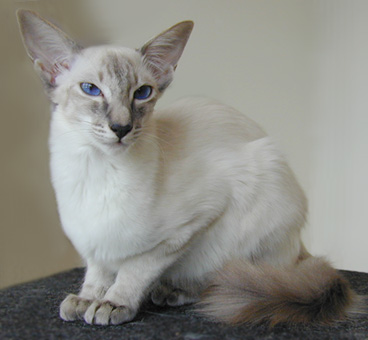Balinese cat
The Balinese cat is a breed of domestic cats , which is characterized by its long hair and is differentiated according to the same color and pattern variants as Siamese cats. Balinese are descended from Siamese cats , but differ in their medium-length hair and a bushy tail.
history
The origin of the Balinese cats is not in Bali or other parts of Indonesia . The breed is not a naturally developed cat breed, but rather developed through intensive breeding. As a cross between long-haired Siamese cats and Angora cats , the first specimens were registered as "long-haired Siamese cats" in the early 1920s . Because long-haired specimens falsified the breed-typical characteristics of the Siamese, they were no longer used for breeding for a long time, but were sold or killed as domestic cats. It was only when the two American breeders Marion Dorsey from California and Helen Smith from New York began to breed Balinese cats for profit in the 1950s that public acceptance changed.
The naming goes back to Smith's subjective feeling that the cats are reminiscent of Balinese temple dancers with their smooth gait and beauty. The long-haired Siamese is too bulky a name for such graceful animals. Since the new name, the breed's popularity increased, so that more and more breeders began to "perfect" the Balinese. Today there are two types of Balinese: traditional and modern Balinese.
Appearance
The Balinese cat is a very slender, muscular longhair cat of medium size. Cats weigh 3 to 4 kg, cats 4 to 5 kg. Typical characteristics of the Balinese cat are the consistently blue eye color, a long, bushy tail and the pointing of the fur on the outer extremities such as the head and ears, tail, paws and, in males, the scrotum.
character
Balinese cats are often very talkative and playful cats. At the same time they are very cuddly, sensitive and just as people-oriented as the related breed of the Siamese cats. If they are not given enough attention, they report in a loud voice. Because the Balinese cat is both headstrong and strong in character.
Shades of color
Colors approved by the European Cat Association FIFé :
- seal-point (= black mark)
- blue-point (= dark gray mark)
- chocolate-point (= brown markings)
- lilac-point (= light gray markings)
- red-point (= red mark)
- creme-point (= cream-colored markings)
- fawn-point (= gray-beige badge)
- cinnamon-point (= cinnamon-colored markings)
- foreign white (= white cat without a mark).
All of these colors (except for foreign white) are also permitted as tabby points (i.e. with striped markings). If you cross a red or cream-colored animal with another color (except white), so-called tortie points are also obtained, and tortie tabby points are also possible as badges.
Only the following colors are allowed in the American Cat Association CFA :
- seal point
- chocolate-point
- blue point
- lilac-point.
All other colors are of the Javanese race , including all tortie and tabby color variants. This leads to confusion again and again because in Europe the oriental longhair cat was sometimes also called Javanese. Tabby points are also referred to as lynx points in the CFA.
The coat markings are only visible in the young animals after a few weeks.
If you mate a Balinese with a Siamese cat, so-called Siamese variant cats are created. These animals are short-haired Siamese cats, but they have long-haired cats. They can thus be used for further breeding of Balinese. The breeding with variants is often carried out in order to adapt the type of the Balinese to the modern Siamese more and more.
intelligence
Of all longhair cats, Balinese cats are proven to have the highest intelligence. You get a score of 9-10 on the Cat Intelligence Scale.
See also
Web links
References and comments
- ↑ J. Anne Helgren, 1997. Barron's Encyclopedia of Cat Breeds: A Complete Guide to the Domestic Cats of North America. Barron's Educational Series, 1997. ISBN 978-0-7641-5067-8 . Quoted from Archived Copy ( Memento of the original from January 5, 2016 in the Internet Archive ) Info: The archive link was inserted automatically and has not yet been checked. Please check the original and archive link according to the instructions and then remove this notice.



